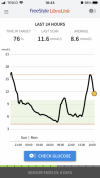@sg295 i think you mentioned you are new to diabetes - welcome to the club.
As I mentioned above, I really like my pump.
BUT it can go wrong. It never goes wrong at a convenient time. Whilst it is rare, it is stressful and I have to be ready to manage it at any time.
Therefore, I was really glad I injected for so long that it is still second nature to me when I need it.
Unless you have a strong reason for pumping (e.g young children need smaller doses than possible when injecting), I recommend sticking with injections for a year or two so you do not panic when your pump fails and not jumping into pumping straight away.

